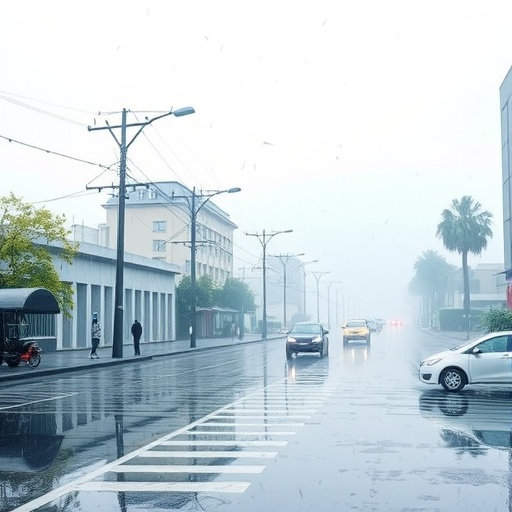In the wake of escalating climate crises, the resilience of emergency response networks is increasingly vital to saving lives and mitigating damage. A groundbreaking study recently published in the International Journal of Disaster Risk Science delves deeply into how these networks withstand extreme environmental shocks, using an intense rainstorm event as a case study. This research, spearheaded by Lian, Guo, and Liu, pioneers a sophisticated analytical model that factors in not just the structural robustness of emergency networks but also the dynamic interrelationships between tasks and the possibility for real-time reassignment of resources.
Traditional emergency response systems have often been critiqued for their static nature—once deployed, resources and personnel have limited flexibility in adapting to evolving scenarios during a disaster. The study challenges this paradigm by investigating how embedding task associations and reassignments into the operational framework can enhance the overall robustness of the network. Such mechanisms, the authors argue, are critical during extreme weather events where the volatility and unpredictability of conditions demand rapid recalibration of response strategies.
Utilizing an extreme rainstorm—characterized by unprecedented precipitation, flooding, and cascading infrastructure failures—as the harsh testing ground, the study builds a comprehensive model of an emergency response network. This model employs high-resolution temporal data capturing task interdependencies, communication pathways, and resource mobilization strategies. By reconstructing the progression of the event, the analysis reveals not only where the network’s structural weaknesses lay, but also where dynamic task reassignment prevented deeper systemic collapse.
A key finding highlights that emergency response efficiency rests significantly on the ability to reassign critical tasks among diverse actors in real time. For example, when flooding rendered certain routes impassable, the model demonstrates how prompt reassignment of logistical and rescue tasks to alternative pathways and teams mitigated delays. This agility prevented bottlenecks and redistributed workload effectively, showcasing the indispensability of flexible task coordination to operational success during extreme weather calamities.
The study also brings to light how task associations—interdependencies between different emergency operations such as evacuation, medical aid, and infrastructure repair—must be explicitly accounted for in network design. Neglecting these interrelations risks cascading failures, where the breakdown of a single task paralyzes related functions. By mapping these connections, the authors illustrate how strategic prioritization of tasks based on their associative impacts fortifies the network’s resilience under stress.
Underpinning the entire framework is an advanced computational simulation platform that integrates real-time data streams, predictive analytics, and optimization algorithms. This platform enables emergency coordinators to visualize and adjust task assignments dynamically, responding to the storm’s unfolding challenges. The authors argue that such integration of data-driven decision-making tools is indispensable for modern emergency management, particularly with increasingly frequent and severe climate-induced disasters.
Moreover, the research underscores the necessity for interoperability between diverse agencies and stakeholders within the emergency response ecosystem. The case study reveals that rigid organizational silos and incompatible communication protocols hindered effective task reassignment and resource sharing. Overcoming these barriers through unified command structures and standardized information systems is crucial to foster a cohesive, adaptive response network.
The implications of this investigation extend beyond rainstorms to other disaster scenarios such as wildfires, earthquakes, and pandemics. The principles of task association and reassignment, combined with digital tools for situational awareness, offer a universal blueprint for enhancing emergency robustness. As climate variability continues to amplify disaster risks globally, the ability to dynamically reconfigure operations will become a defining feature of resilient communities.
The research also calls for investment in training programs that prepare emergency responders to work within these fluid task frameworks. Ensuring that personnel understand the connectivity between operations and are equipped to shift roles swiftly in crisis increases the effectiveness of reassignment protocols. This human element complements technological advancements, creating a synergistic capability for robust disaster management.
While the study is comprehensive, it highlights ongoing challenges such as data availability, real-time communication reliability, and resource limitations that may constrain practical implementation. Future work is suggested to explore how machine learning techniques might further optimize task reassignments, as well as how community engagement can be incorporated into the response networks to leverage local knowledge during emergencies.
In sum, Lian, Guo, and Liu’s research offers a compelling vision for the future of emergency response networks, one where adaptability is systematized and supported by modern computational infrastructure. Their case study of an extreme rainstorm serves as a powerful testament to how understanding and operationalizing task dependencies and flexible reallocations can dramatically enhance survivability and recovery speed during natural disasters.
This paradigm shift in emergency response thinking marries technology, organizational theory, and disaster science to craft networks that are not only robust but also resilient by design. As climate crises worsen, applying these insights could mean the difference between chaos and coordinated action in disaster-stricken regions. This research invites policymakers, scientists, and emergency practitioners to rethink conventional models and embrace dynamic task frameworks as central to disaster resilience strategies.
The findings and methodologies presented herald a new era in disaster risk management, emphasizing the necessity of sophisticated, responsive, and interconnected emergency systems. With the increasing complexity and scale of threats, the ability to adapt swiftly through intelligent task association and reassignment will define successful humanitarian interventions. This study lays the groundwork for deploying such innovations in field operations, ultimately saving more lives and reducing societal costs in future calamities.
Subject of Research: Emergency response network robustness considering task association and reassignment during extreme weather events.
Article Title: Exploring the Robustness of Emergency Response Networks by Considering Task Association and Reassignment: An Extreme Rainstorm Case.
Article References:
Lian, C., Guo, Y. & Liu, J. Exploring the Robustness of Emergency Response Networks by Considering Task Association and Reassignment: An Extreme Rainstorm Case. Int J Disaster Risk Sci (2025). https://doi.org/10.1007/s13753-025-00670-1
Image Credits: AI Generated




